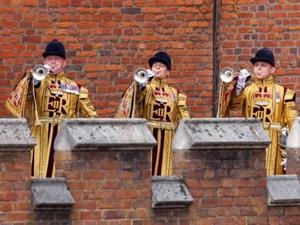Charles III was proclaimed King of the United Kingdom at a historic ceremony held today at St James’s Palace in London. The ceremony was televised for the first time in history. During the trials, flags were lowered in honor of the deceased queen to celebrate the new king. Flags were hoisted full-pole for up to an hour after proclamations in Scotland, Northern Ireland and Wales. Then, until September 19, II. They will mourn Elizabeth’s death in half.
He was proclaimed the new king by the Council of Ascension, and following his proclamation as monarch, he said in his oath that he was “deeply aware” of the “duties and great responsibilities” of his role. A number of other papers are due in the UK by tomorrow.
The monarch also said he was “deeply encouraged” by the support of Queen Consort Camilla, whom he calls his “beloved wife”.
What is the Ascension Council proclamation?
Charles was already king under the Act of Settlement of 1701. He automatically became king after his mother’s death. Thus, the purpose of the Council of Ascension was ceremonial to officially proclaim the name of the new ruler.
The proclamation usually takes place within the 24th of the monarch’s death, but on this occasion it took a little longer. No English monarch has waited this long to take the throne, and Charles III will have to wait for his coronation, whose date has yet to be determined – his mother waited for more than a year.
Who attended?
More than 200 members of the Privy Council, made up of the monarch’s official advisors and mostly politicians past and present, met with the clergy at the Palace of Saint James.
Also present were former British Prime Ministers John Major, Tony Blair, Gordon Brown, David Cameron, Boris Johnson and Theresa May. In addition to these, the Mayor of London Sadiq Khan, senior judges, current Prime Minister Liz Truss and other officials were also present.
Queen consort Camilla Parker Bowles and the king’s son and new Prince William of Wales were also present.
Appointment as king
The Council of Ascension was divided into two parts, and Charles only appeared in the second part.
For the declaration, the Privy Council, called the group of advisers of the monarchy, met twice. The first part took place for the monarch to be declared without his presence.
“Prince Charles Philip Arthur George now, the ruler of our happy memories, upon the death of our King Charles III… God bless the King!” the council declared, before the monarch himself was summoned to the chamber.
The statement was also read in Belfast, Cardiff, Edinburgh and elsewhere in the country.
king’s speech
The second part of the Ascension Council was when the Privy Council greeted the new king in the Throne Room of the Palace of Saint James. It was the first meeting of the Privy Council organized by the new monarch. Accompanied by his wife, Queen Camilla, Charles and their eldest son William, the heir to the throne, held their first meeting.
Since tradition dictates that no one sits in the Privy Council, the councilors lined up to receive him, all standing. In an emotional first speech to the council, the monarch said that everyone’s solidarity with the loss of her mother was “a great consolation” for him and the entire family, and Elizabeth set an example.
What oath did King Charles take?
Under the terms of the Union Act, new monarchs are also required to take an oath to uphold and protect the Church of Scotland. This is because there is a separation of powers between church and state in Scotland.
Charles signed two copies of the oath before the Privy Council. Witnesses also signed these vows, including Prince William and then Queen consort Camilla. As the last witnesses signed the statement, a band started playing.
Charles could object to any of the oaths he was asked to take, but the last time a new monarch did so was in 1910, when King George Fifth rejected the anti-Catholic text of the proclamation oath.
What will happen now?
The ceremony concluded with the secretary of the Privy Council declaring Charles “King, President of the Commonwealth, Defender of the Faith” and said “God bless the King”. The ceremony was attended by the reading of the draft papers to be approved and the King III. It ended with Charles confirming one by one.
Next, members of Parliament – deputies and lords – swear allegiance to the monarch and offer their condolences. In the afternoon, Charles III greets Truss and the newly appointed key members of the executive staff.
It may take some time for the coronation to take place. Queen Elizabeth’s father, King VI. About 16 months passed between George’s death in February 1952 and his coronation in June 1953.
* with the BBC
source: Noticias




